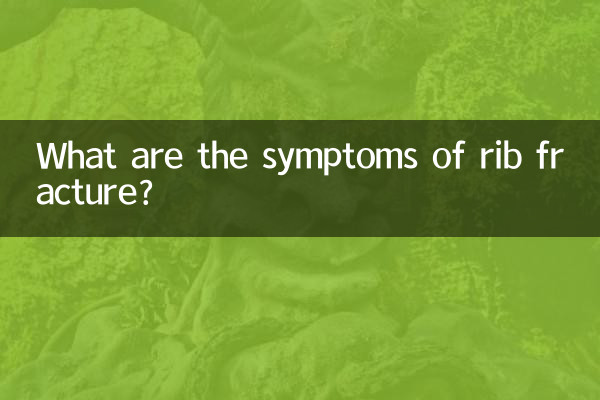What are the symptoms of rib fracture?
Rib fractures are a common chest injury, usually caused by accidents such as impact, falls, or traffic accidents. In recent years, with the increase in sports injuries and traffic accidents, cases of rib fractures have also increased. This article will detail the symptoms, diagnosis, and treatment of rib fractures to help everyone better understand this disease.
1. Common symptoms of rib fractures

Symptoms of rib fractures vary from person to person, but here are some of the most common signs:
| Symptoms | Description |
|---|---|
| chest pain | Severe pain may occur at the fracture site, especially when taking deep breaths, coughing, or moving. |
| difficulty breathing | Because of the pain, the patient may avoid taking deep breaths, resulting in shallow, rapid breathing. |
| localized swelling or bruising | There may be swelling, bruising, or red skin at the fracture site. |
| Bone scratching feeling | You may feel a sound or sensation of bones rubbing together when you touch the fracture site. |
| Cough or coughing up blood | If the fracture damages the lungs, it may cause coughing or coughing up blood. |
2. Diagnostic methods of rib fractures
If you suspect you or someone else has a rib fracture, seek medical attention promptly. Doctors usually diagnose by:
| diagnostic methods | Description |
|---|---|
| Physical examination | Your doctor will examine the painful area to see if there is any swelling, bruising, or scratching. |
| X-ray examination | X-rays can clearly show the location and extent of a fracture. |
| CT scan | For complex fractures, CT scans can provide more detailed three-dimensional images. |
| MRI examination | MRI can show soft tissue damage, such as damage to the lungs or blood vessels. |
3. Treatment methods for rib fractures
Treatment of rib fractures is usually divided into conservative and surgical treatments, depending on the severity of the fracture:
| Treatment | Applicable situations | Specific measures |
|---|---|---|
| Conservative treatment | Simple fracture without serious complications | Rest, pain relievers, ice, and avoid strenuous activity. |
| surgical treatment | Multiple fractures or severe complications | Surgery fixes fractures and repairs damaged organs. |
| physical therapy | recovery period | Breathing training and progressive exercise can help restore lung function. |
4. Rehabilitation and prevention of rib fractures
The recovery period for a rib fracture usually takes 6-8 weeks. During this period, you should pay attention to the following points:
1.Avoid strenuous exercise:Until the fracture heals, any activities that may aggravate the injury should be avoided.
2.Eat properly:Eat more foods rich in calcium and vitamin D to promote bone healing.
3.Regular review:Regularly review the fracture as recommended by your doctor to ensure normal healing of the fracture.
4.Precautions:Pay attention to safety in daily life and avoid falls or impacts, especially for the elderly and athletes.
5. Complications of rib fractures
If a rib fracture is not treated promptly, the following complications may occur:
| Complications | risk |
|---|---|
| pneumonia | Lung infection may occur due to restricted breathing. |
| Pneumothorax | The fracture punctures the lung tissue, allowing air to enter the chest cavity. |
| Hemothorax | The fracture damages blood vessels, causing blood to pool in the chest. |
| Visceral damage | Severe fractures may damage organs such as the liver and spleen. |
Conclusion
Rib fractures, although common, can lead to serious complications if left untreated. If you or someone around you develops the above symptoms, please seek medical advice promptly. With scientific diagnosis and treatment, most patients with rib fractures can recover successfully. At the same time, strengthening awareness of daily protection and avoiding accidental injuries is the key to preventing rib fractures.

check the details

check the details